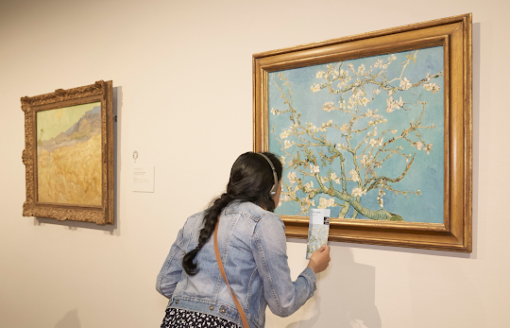Your cart is currently empty!
WAYS OF NOT SEEING

If, as John Berger writes, “Oil painting… is a celebration of private property”, then Street Art is the equally joyous appreciation of public property. This difference is due to the nature of the work and their contrasting environments: Graffiti beats the streets while “oil painting” luxuriates in museums. So, other than both being categorized as Art, there’s not that much similarity between the two; in fact, the difference is so great that entirely separate skill sets are required to properly experience them.

The Van Gogh Museum in Amsterdam is one of Holland’s greatest tourist destinations and at certain hours, as crowded as the nearby Centraal railway station. Here, tour groups dedicated to the Myth of Van Gogh mix it up with individuals seeking a private audience with the artist. Meanwhile, new arrivals aggregate around them like an out-of-control assembly line, each person anticipating their own virtual moment with Vincent in Arles. Everyone appears dumbfounded, like the devout reaching the ultimate destination of a pilgrimage, their rosaries exchanged for earbuds. Unfortunately, this “bogus religiosity” as Berger describes it, requires unfettered observation so the line of faithful at each painting moves at a geologic pace. But that’s OK, since to really be appreciated, Van Gogh’s subjects and techniques require a pensive approach.

Just across the Museumplein, Amsterdam’s MOCO museum recently hosted an unofficial show of work by the Street Artist Banksy. This contemporary art museum, “founded with the mission of attracting broader and younger audiences”, exhibits Pop Surrealism, Street Art, and works by a few “old masters” like Andy Warhol or his doppelganger, Elaine Sturtevant. MOCO is located in a 19th century mansion, so its galleries are small yet seem perfectly suited for hosting a crowd essentially the same size as the manageable coat check lines at the Van Gogh Museum. But even at those numbers, Banksy’s exhibition was denser and more uncomfortable than Van Gogh’s. People were colliding with each other constantly; plus, kids with backwards baseball hats and extra wide Sharpies aren’t going to apologize when someone’s crows-in-a-cornfield poster gets crunched. Worse than that, more than a few people waited to get up close and personal with a Banksy only to find out they were in the restroom line.

I call the cause of all this aesthetic anguish Attention Surfeit Disorder, and it occurs when an art viewer deems a simple work of art worthy of the same extended investigation as a complex one. For example, MOCO’s version of the famous Banksy chimpanzee piece “Laugh Now, But One Day We’ll Be In Charge”, had more people lined up to gawk at it than Van Gogh’s sunflower painting. For a single stencil piece to garner that much attention is crazy; for a multiple of the same image, its certifiably insane. Banksy is a master of the static meme and what he scribes can be sussed out later; there’s no need for a lengthy on-the-spot evaluation. Graffiti’s economy of means demands economy of attention, so people are either going to get the message or not. And if they don’t, then they should heed that famous line used by London bobbies, “Move along, nothing to see here.”

Comments
5 responses to “WAYS OF NOT SEEING”
Great take Mr. Ausgang. Wish I could fly there tomorrow to take them both in.
Once again, a nice short interesting read. Thanks.
Nice one AA!!
What a contrast! Art shelters under a macrocosmic umbrella. Is anyone else annoyed by how Van Gogh has been so badly discounted, appearing on napkins and paper plates, motel room art, lamp shades, ad nauseum? It makes me mad. I used to love his work and now it looks cheesy to me. Ditto Monet’s lillies. The fault lies in me, I know. Still, I harbor resentments …
I loved this article. Mainly since I am one of the old people trying to make art that people will stand in front of for more than two seconds! I love your insights and you are a wonderful writer!
I agree with Rosalie though about Van Gogh over-reproduction taking the magic out of it.